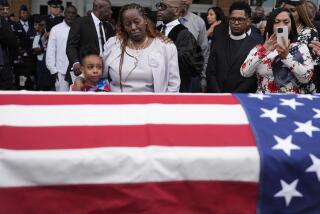Family’s Long Wait Is Over : World War II Airman Is Laid to Rest 47 Years Later
- Share via
A World War II picture of a youthful Army Air Corps gunner sat on top of a flag-draped casket during a memorial Mass in Boyle Heights. The service honored Sgt. Ernest Bustamante, whose airplane was reported missing 47 years ago.
“Today we are celebrating the return of my brother Ernie,” Gil Bustamante told family and friends who gathered with an honor guard of veterans at Our Lady of Talpa Catholic Church.
Sgt. Bustamante’s family always hoped to learn more about his wartime disappearance. His mother died knowing only that he was missing in action and presumed dead. But now his surviving relatives know he is finally home from a South Pacific jungle. With pride they arranged for his burial in late September at Arlington National Cemetery in Virginia.
The remains were discovered by American missionaries in 1988. The Department of Defense began working to trace the family name through birth and cemetery records and finally, last July 3, found Gil at his home in Whittier.
“He was out in the back, reading, when the telephone rang,” said his wife, Sylvia. “He’s so hard of hearing he would have never gotten that call if I wasn’t home.”
The woman on the other end of the line first asked questions to verify their kinship and whether family members had lived at a Boyle Heights address at one time. That confirmed, Sylvia Bustamante handed over the phone to her husband.
“He got to the phone, and then he had a big smile on his face, and then tears. I just couldn’t imagine. Then he whispered to me, ‘They found Ernie.’ ”
Sylvia Bustamante had seen an article in a local newspaper in 1988 about the discovery of a U.S. airplane in a New Guinea jungle. Sensing that it might have belonged to the brother-in-law she never knew, she saved the article.
Now, Gil, brother Frank Bustamante and sister Dolores McCloskey gather to look over Ernest’s belongings--a 1942 Roosevelt High School yearbook and the articles found on the plane. One item, an indiscernible religious medal, has turned green and orange and is crumbling. The dog tags are rusted green as well.
What is described by the Army as a compass looks like a closed pocket watch, which Gil fears is too fragile to open. Also found were his brother’s wings, which are still shiny.
In a picture taken before his death, Sgt. Ernest Bustamante’s young, handsome face is topped with a leather cap that was part of his Army Air Corps uniform. The wings gleam from his leather jacket. He enlisted in 1942. His plane, which also carried pilot Carl H. Hansen, disappeared on March 13, 1944.
The airplane, an A-20G, was part of the 389th Bombardment Squadron assigned to patrol the area and attack airfields, troop positions, bridges and warehouses on the northern and western coasts of New Guinea. On the day the plane disappeared, it was part of a flight of four aircraft that completed a bombing and strafing mission and then circled above crew members from a plane that had crashed into the sea until they were picked up by the Navy, according to a written summary of the incident given to the family.
The planes left the area and started to climb over the mountains southwest of Saidor, but the flight leader decided that the bad weather and limited visibility would make it impossible to cross. He changed course, but was the only one to make it back to the base.
Back in Los Angeles, Francisca B. Bustamante received a telegram with news that her son was reported missing. After that, she received telegrams every time the Army made a new determination--that Ernest was presumed dead in 1946 and that his remains were determined to be “non-recoverable” in 1949.
She died in 1985, but according to her children, she never gave up hope that her son was alive and would be found someday. As a result, the family had not held a funeral for Ernest.
“My mother lived till she was 86, and she kept it up until that time,” Gil Bustamante said. She kept candles burning and prayed to the Sacred Heart of Jesus and the Virgin Mary.
It was through their mother’s birth and death records that the woman caller found the Bustamante family. When she went to claim Ernest’s insurance years ago, Mrs. Bustamante had sent to Washington part of a brown paper bag, which verified her birth in Tucson by a midwife in 1898. That information led searchers to contact Southern California cemeteries, looking for her name. When they found that she was buried at Calvary Cemetery in Whittier, they simply asked who paid the bill and found Gil.
At the Sept. 18 Mass, Rogelio (Roger) Rueda, a member of Montebello Post 272 of the American Legion, talked about his best friend Ernie. The boys’ back yards had abutted and the two grew up jumping the fence to visit each other. Rueda said they spent their days playing in the neighborhood junkyard, hopping cable cars and learning to drive.
When President Franklin D. Roosevelt asked Congress to declare war on Japan, Ernie was eager to join the military, but Roger managed to slow him down with the assurance that the military would find them soon enough.
“Sgt. Ernest was a beautiful person,” said the gray-haired, bespectacled Rueda, 68. “Ernie and I, we played together, went to school together, we worked and we came to our church, Our Lady of Talpa.
“I won’t say goodby, Ernie. I will say till we meet again.”
More to Read
Sign up for Essential California
The most important California stories and recommendations in your inbox every morning.
You may occasionally receive promotional content from the Los Angeles Times.













